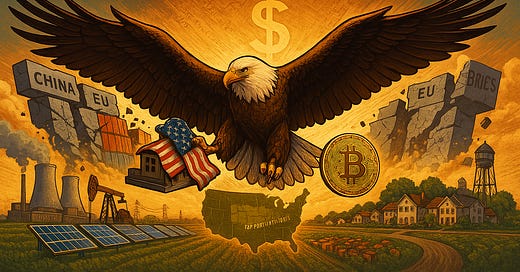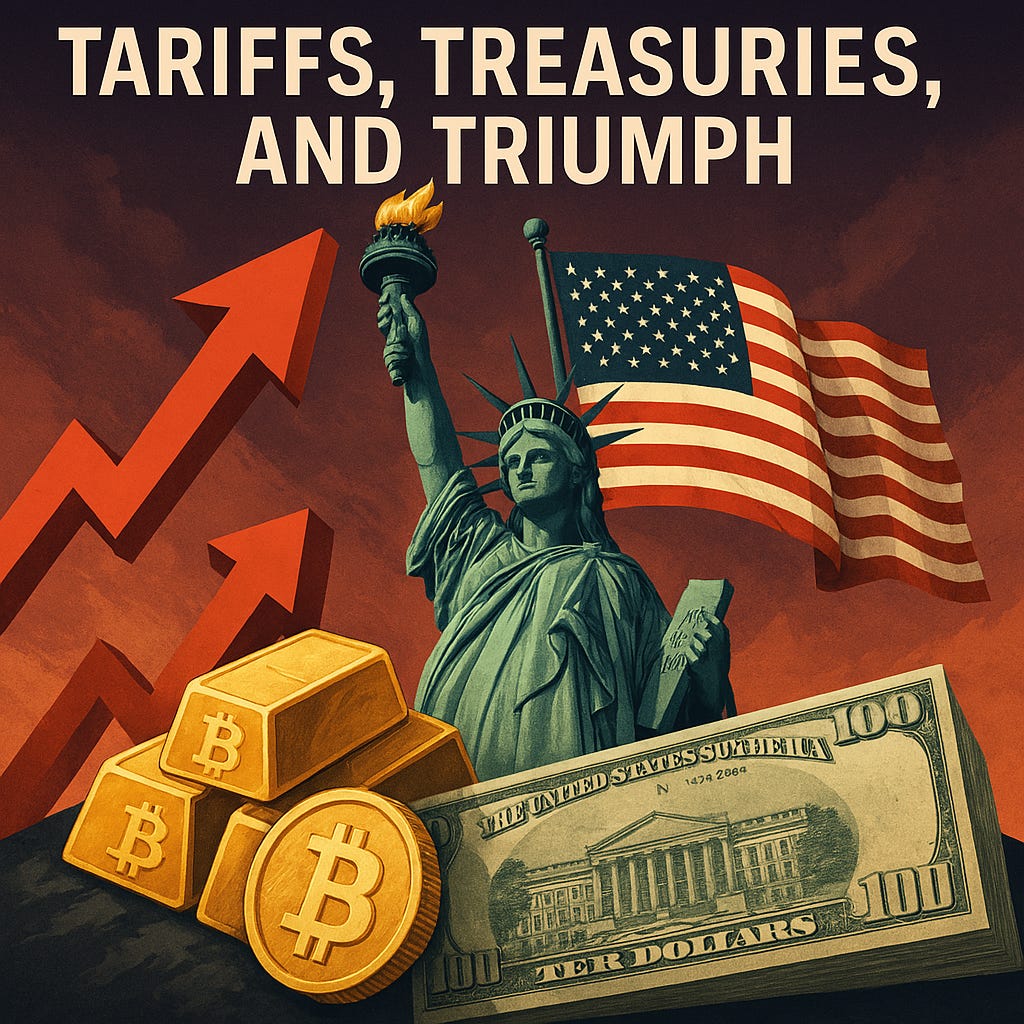Economic Checkmate:
Tariffs, Treasuries, and Triumph. Trump’s Bold Bet to Reshape the 21st Century
President Donald Trump’s 2025 trade policy may be the most polarizing economic playbook of the modern era. Critics call it chaotic, reckless, and a throwback to failed protectionism. But what if this bold mix of reciprocal tariffs, industrial policy, dollar supremacy, and even Bitcoin isn’t chaos—but a game-theory masterclass in choreography?
A decisive, strategic, and bold maneuver that leaves rivals with no viable countermove. Just like in chess, Trump’s trade doctrine appears chaotic to the untrained eye—but from a higher perspective, each move (tariffs, Bitcoin reserves, reshoring, dollar diplomacy, tax, and Opportunity Zone (bipartisan) extensions is setting up an endgame scenario where the U.S. holds all the leverage.
As Scott Bessent (U.S. Treasury Secretary) said yesterday, “This is not a MAGA problem, it is an idiosyncratic Mag 7 stock problem.”
For quarterly earnings-driven captains of industry and finance, it’s an unwelcomed whipsaw in the short run, but when the necessary goal is to manage a beautiful deleveraging right back into long-term productivity growth, this is an incredibly orchestrated strategy that the polarized media will most likely fail to cover in proper detail so I will do my best to layout the moving parts of this historic move below to give you a full picture of what and how to form your own opinion and strategy from.
This isn’t merely about politics. It’s about positioning America for the next century of global leadership—while shifting the game board beneath rivals, reshoring strategic industries, and opening a once-in-a-generation opportunity for investors and Main Street alike. It’s a policy built on the uncomfortable truth that the current world order no longer serves American workers or innovation—and the playbook is being rewritten in real-time.
Unpopular Opinion: The President’s team and bold moves are forcing bipartisan action in Congress with these moves, which not only prove that checks and balances still exist in our constitutional republic but also that this kind of executive leadership is mandating more examples like Senator Tim Kaine (D) and Senator Rand Paul (R) co-sponsoring a joint resolution to block the tariffs on Canada. The President and current administration are working at a feverish pace and putting everyone else in public service on that same benchmark of effort and are exposing those who have been far too comfortable or incompetent for far too long. It is already working, as Ontario Premier Doug Ford has already said in the last 12 hours that he is open to immediately dropping all their tariffs the minute the U.S. agrees to stop theirs. The U.K. and Mexico leadership have also expressed their understanding that the only way out of checkmate is to find a way forward before the end of the week.
I am aware that nothing happens in a vacuum and that those who wish to derail this strategy for their own preservation of the current status quo could prove my opinion and analysis wrong, but in the game of probabilities, I will break down why I believe this is more likely to play out as conceived below.
From Disruption to Design: Understanding the Method in the Madness
I’ll start by acknowledging the loudest concerns.
Critics say Trump’s strategy will:
Raise prices for consumers via tariffs.
Prompt retaliation from allies and rivals alike.
Trigger inflation or even stagflation.
Alienate global trading partners.
Spark market volatility.
All true—in the short term. But viewed through the lens of long-term national strength, the convergence of Trump’s trade, fiscal, and industrial strategies reveals a historic power move rooted in America’s own past successes.
The Truth is There are No Good Counters for Rivals.
China is weakened by reshoring and tariff pressure.
BRICS can’t truly de-dollar without imploding their own liquidity.
The EU is divided and energy-dependent.
Digital assets give the U.S. a hedge others don’t have access to.
Main Street is revitalized through Opportunity Zones and tax policies that attract trillions.
It’s a multi-front convergence that ensures others have to adapt to U.S. terms—or lose. And they can’t afford to lose for very long.
The Strategic Pillars of the 2025 Trade Doctrine
1. Reciprocal Tariffs: Pain Now, Strategic Leverage Later
Trump’s revival of reciprocal tariffs isn’t random—it’s rooted in historical precedent and calculated geopolitical leverage. His executive memorandum on “America First Trade Policy” focuses on three goals:
Ending unfair trade practices
Securing supply chains
Protecting U.S. national security industries
Think of these tariffs as carrots and sticks. Countries or corporations that want access to the U.S. consumer base must bring jobs, innovation, and investment stateside—or face economic consequences.
After 2018’s initial tariff volleys, foreign direct investment in the U.S. surged. Semiconductor giants like TSMC and Samsung committed billions to build plants in Arizona and Texas. Expect that trend to accelerate under the 2025 doctrine, with automotive, advanced manufacturing, and energy sectors following suit.
2. Dollar Dominance: The Unshakable Core of U.S. Power
Roughly 70% of global debt and over half of all trade invoices are in U.S. dollars. Despite noise about de-dollarization, the dollar remains the axis around which global finance spins, and nothing can unwind in a short period of time to pose a high probability threat to this dominance.
This financial dominance allows the U.S. to impose tariffs and sanctions with limited blowback. Even countries exploring alternatives—like BRICS+—lack the liquidity, trust, and institutional maturity of dollar-denominated markets.
During past global shocks—from 2008 to COVID—dollar demand surged. Today’s strategy wields that same gravitational pull to align global behavior with U.S. economic interests.
3. Bitcoin Reserve: Future-Proofing Against Global Volatility
Here’s where the strategy leaps into the 21st century:
Trump’s 2025 directive to establish a Strategic Bitcoin Reserve using confiscated assets (~200,000 BTC) positions the U.S. as the world’s first dual-monetary superpower.
It’s a hedge. Against fiat debasement, systemic crises, or geopolitical turbulence.
It’s a flex. While China bans Bitcoin, America weaponizes it as digital gold.
It’s optionality. A high-tech tool in a low-trust world.
This reserve doesn’t threaten the dollar—it complements it and signals leadership in the future of decentralized finance. It also provides the U.S. Treasury some necessary autonomy and reclaimed sovereignty against the Fed’s independent monetary policy-making.
4. Geoeconomic Strategy: Trade as Diplomacy, Not Just Economics
Tariffs aren’t just about economics. They’re tools of geopolitical alignment.
Allies who invest in America gain tariff exemptions and bilateral benefits (like the revised USMCA).
Rivals like China are forced to play ball or lose access to critical export markets.
This approach blends hard power (military) and economic influence, echoing Cold War-era strategy but updated for a multipolar digital world.
History Says This Strategy Works
Protectionist panic isn’t new. Let’s rewind:
1960s: Germany taxed U.S. chicken; the U.S. retaliated with a 25% tariff on German trucks (the “Chicken Tax”)—protecting American automakers.
1980s: Japan faced quotas to avoid tariffs. It helped Detroit breathe and innovate.
2001–2015: China’s WTO entry brought cheap goods—and a “China Shock” that cost the U.S. millions of factory jobs.
Tariffs are shock therapy. Yes, they cause short-term pain. But historically, they’ve forced rivals to negotiate, reshaped supply chains, and protected national industries during periods of transition.
What Media Misses: Fear Is a Feature, Not a Bug
Economic fear—when used strategically—drives recalibration:
Companies rush to reshore supply chains to avoid tariffs.
Countries fearing dollar exclusion or sanctions comply with U.S. interests.
Investors fleeing uncertainty seek refuge in U.S. Treasuries, hard assets, and Bitcoin.
Volatility, properly managed, is leverage. It creates windows of opportunity—for those who know where to look. Buy.The.Dip.
Who Wins? The Surprising Upside for Main Street and Investors
Trump’s playbook may disrupt Wall Street’s assumptions (which is why your news feed will be filled with angry politicians and economic pundits who protect the Wall Street interests, but it creates long-term alpha for industries, workers, and investors who align with the reshoring revolution.
Main Street America
Construction & Skilled Trades: Semiconductor fabs, battery gigafactories, defense facilities, and mining operations need local labor.
Rural Renaissance: Mines in Nevada, critical mineral processing in Texas, energy infrastructure in Louisiana—regions left behind are now front and center.
Small Business Suppliers: Reshoring creates ripple effects for logistics, parts, and services.
Sector Winners
Industrials: Caterpillar, Deere, and U.S.-based factory equipment makers.
Semiconductors: TSMC, Intel, Micron—especially those with domestic footprints.
Strategic Energy: Traditional oil and gas, nuclear, solar, and wind all win from energy security policy—alongside rare earth mineral processors.
Defense & Aerospace: Tariffs on foreign competitors will bolster U.S. suppliers.
Digital Assets: Bitcoin miners, blockchain infrastructure, and cold storage security firms.
BONUS LEVER: The Trillion-Dollar Catalyst for Jobs, Housing, and Investment
Two fiscal tools could supercharge this strategy and unleash trillions in long-term investment if renewed and expanded:
1. Tax Cuts and Jobs Act (TCJA) Renewal
The TCJA of 2017 laid the foundation for the last economic expansion by:
Lowering corporate taxes
Allowing accelerated depreciation
Providing tax relief for small businesses
If renewed in 2025, it would give U.S.-based manufacturers, energy producers, and startups the certainty they need to deploy long-term capital, expand payrolls, and innovate domestically.
2. Opportunity Zone (OZ) Extension
Originally passed in 2017, the Opportunity Zone legislation encouraged investors to defer and reduce capital gains taxes by investing in over 8,700 designated distressed communities across America.
With a ticking sunset clause in 2026, a 10-year extension could:
Attract trillions in new capital into real estate, infrastructure, startups, and advanced manufacturing
Spur job creation, housing development, and small business growth
Reignite Main Street economies from Appalachia to inner cities and tribal lands
Together, these two policy levers would act as rocket fuel—amplifying the impact of Trump’s trade doctrine while providing long-term ROI for both investors and communities.
How to Position Your Portfolio and Career for the Next Wave
For Investors:
Increase exposure to industrial ETFs and U.S. manufacturing leaders
Explore Bitcoin-linked equities and cold storage infrastructure
Invest in energy across the board—oil, gas, renewables, and nuclear
Watch Opportunity Zone funds and local FDI data for hidden gems
NOTE: ATOMIQ QOZ is closing its latest QOZB acquisition fund, and if you would like a prospectus, email me cjs@atomiqcapital.com
For Families and Professionals:
Upskill in tech-adjacent trades: robotics, semiconductors, cybersecurity
Relocate to emerging boomtowns: think Texas Triangle, Arizona, and the Southeast
Leverage community college programs tied to reskilling and federal investment zones
Conclusion: The Coming Golden Age—If We Seize It
America’s 21st-century trade doctrine isn’t just a reaction to unfairness—it’s a blueprint to reshape the world order.
Dollar dominance remains the bedrock
Tariffs are the chisels reshaping global supply chains
Bitcoin is the optionality for a digital-first future
Tax and opportunity legislation are the fuel for nationwide reinvestment
Fear wielded well, creates alignment
This isn’t about winning a trade war. It’s about rebuilding the industrial and geopolitical backbone of America for the next century.
For families willing to retrain, for investors willing to reposition, and for entrepreneurs ready to innovate—this is your moment. Whether you love or loathe Trump, you cannot ignore the scope of what’s unfolding.
Don’t get caught watching history. Start participating in it and profit from it!
Yours in health and wealth,
~Chris J Snook





